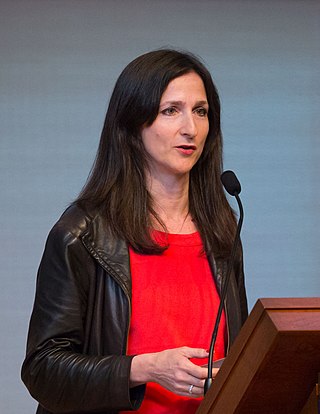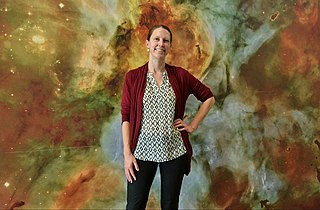Related Research Articles

A planet is a large, rounded astronomical body that is neither a star nor its remnant. The best available theory of planet formation is the nebular hypothesis, which posits that an interstellar cloud collapses out of a nebula to create a young protostar orbited by a protoplanetary disk. Planets grow in this disk by the gradual accumulation of material driven by gravity, a process called accretion. The Solar System has at least eight planets: the terrestrial planets Mercury, Venus, Earth, and Mars, and the giant planets Jupiter, Saturn, Uranus, and Neptune. These planets each rotate around an axis tilted with respect to its orbital pole. All the major planets of the Solar System other than Mercury possess a considerable atmosphere, and some share such features as ice caps, seasons, volcanism, hurricanes, tectonics, and even hydrology. Apart from Venus and Mars, the Solar System planets generate magnetic fields, and all the major planets except Venus and Mercury have natural satellites. The giant planets bear planetary rings, the most prominent being those of Saturn.
George Wetherill was a physicist and geologist and the director emeritus of the department of terrestrial magnetism at the Carnegie Institution of Washington, DC, US.

Planetary habitability is the measure of a planet's or a natural satellite's potential to develop and maintain environments hospitable to life. Life may be generated directly on a planet or satellite endogenously or be transferred to it from another body, through a hypothetical process known as panspermia. Environments do not need to contain life to be considered habitable nor are accepted habitable zones (HZ) the only areas in which life might arise.

Sara Seager is a Canadian–American astronomer and planetary scientist. She is a professor at the Massachusetts Institute of Technology and is known for her work on extrasolar planets and their atmospheres. She is the author of two textbooks on these topics, and has been recognized for her research by Popular Science, Discover Magazine, Nature, and TIME Magazine. Seager was awarded a MacArthur Fellowship in 2013 citing her theoretical work on detecting chemical signatures on exoplanet atmospheres and developing low-cost space observatories to observe planetary transits.

Heidi B. Hammel is a planetary astronomer who has extensively studied Neptune and Uranus. She was part of the team imaging Neptune from Voyager 2 in 1989. She led the team using the Hubble Space Telescope to view Shoemaker-Levy 9's impact with Jupiter in 1994. She has used the Hubble Space Telescope and the Keck Telescope to study Uranus and Neptune, discovering new information about dark spots, planetary storms and Uranus' rings. In 2002, she was selected as an interdisciplinary scientist for the James Webb Space Telescope.

CoRoT-7b is an exoplanet orbiting the star CoRoT-7 in the constellation of Monoceros, 489 light-years from Earth. It was first detected photometrically by the French-led CoRoT mission and reported in February 2009. Until the announcement of Kepler-10b in January 2011, it was the smallest exoplanet to have its diameter measured, at 1.58 times that of the Earth and the first potential extrasolar terrestrial planet to be found. The exoplanet has a very short orbital period, revolving around its host star in about 20 hours.

Planetary science is the scientific study of planets, celestial bodies and planetary systems and the processes of their formation. It studies objects ranging in size from micrometeoroids to gas giants, aiming to determine their composition, dynamics, formation, interrelations and history. It is a strongly interdisciplinary field, which originally grew from astronomy and Earth science, and now incorporates many disciplines, including planetary geology, cosmochemistry, atmospheric science, physics, oceanography, hydrology, theoretical planetary science, glaciology, and exoplanetology. Allied disciplines include space physics, when concerned with the effects of the Sun on the bodies of the Solar System, and astrobiology.

The Nexus for Exoplanet System Science (NExSS) initiative is a National Aeronautics and Space Administration (NASA) virtual institute designed to foster interdisciplinary collaboration in the search for life on exoplanets. Led by the Ames Research Center, the NASA Exoplanet Science Institute, and the Goddard Institute for Space Studies, NExSS will help organize the search for life on exoplanets from participating research teams and acquire new knowledge about exoplanets and extrasolar planetary systems.
The Carl Sagan Institute: Pale Blue Dot and Beyond was founded in 2014 at Cornell University in Ithaca, New York to further the search for habitable planets and moons in and outside the Solar System. It is focused on the characterization of exoplanets and the instruments to search for signs of life in the universe. The founder and current director of the institute is astronomer Lisa Kaltenegger.

Heather A. Knutson is an astrophysicist and professor at California Institute of Technology in the Division of Geological and Planetary Sciences. Her research is focused on the study of exoplanets, their composition and formation. She won the American Astronomical Society's Newton Lacy Pierce Prize in Astronomy for her work in exoplanetary atmospheres.
Sarah T. Stewart-Mukhopadhyay is an American planetary scientist known for studying planet formation, planetary geology, and materials science. She is a professor at the University of California, Davis in the Earth and Planetary Sciences Department. She was a professor at Harvard University Department of Earth and Planetary Sciences from 2003 to 2014.
Aomawa L. Shields is an associate professor of physics and astronomy at UC Irvine. Her research is focused on exploring the climate and habitability of small exoplanets, using data from observatories including NASA's Kepler spacecraft. Shields was a 2015 TED Fellow, and is active in science communication and outreach. She develops interactive workshops to encourage self-esteem and teach about astronomy, combines her training in theater and her career in astronomy.
Rebekah Dawson is an American astrophysicist and an associate professor of astronomy and astrophysics at Pennsylvania State University. Her research focuses on simulating the evolution of exoplanetary orbits and compositions to better understand how planetary systems form.

Ravit Helled is a planetary scientist and a professor in the department of astrophysics and cosmology at the University of Zürich. She studies gas giant planets in the Solar System and exoplanets.
Anat Shahar is a staff scientist at the Earth and Planets Laboratory, Carnegie Institution of Washington and adjunct professor at the University of Maryland. Her work uses high-pressure, high-temperature experiments and stable isotope geochemistry to understand the formation of planets in the Solar System.
Sarah Hörst is an associate professor of planetary sciences at Johns Hopkins University, who focuses on understanding planetary atmospheric hazes, in particular the atmosphere of Saturn's moon Titan.

Nikole Lewis is an astrophysicist and an assistant professor of Astronomy at Cornell University.
Caroline Morley is an American scientist, teacher and astronomer researching exoplanet atmosphere science.
Ilaria Pascucci is an Italian-American astrophysicist and planetary scientist known for her research on exoplanets, protoplanets, the formation of planets, and protoplanetary disks, using a combination of theory, simulation, and observation. Pascucci is a professor and associate department head in the Lunar and Planetary Laboratory at the University of Arizona.
Katharina Lodders is a German-American planetary scientist and cosmochemist who works as a research professor in the Department of Earth and Planetary Sciences at Washington University in St. Louis, where she co-directs the Planetary Chemistry Laboratory. Her research concerns the chemical composition of solar and stellar environments, including the atmospheres of planets, exoplanets, and brown dwarfs, and the study of the temperatures at which elements condense in stellar environments.
References
- ↑ Rosen, Julia (June 1, 2015), "Exoplanets could have long-lived oceans", Earth, retrieved 2022-05-21
- ↑ Lerner, Louise (March 15, 2021), "There might be many planets with water-rich atmospheres", UChicago News, University of Chicago, retrieved 2022-05-21
- ↑ Wood, Charlie (April 19, 2021), "Astronomers cooked up alien atmospheres in an oven", Popular Science, retrieved 2022-05-21
- ↑ Fuge, Lauren (March 30, 2022), "Bombardments from outer space shaped the atmosphere", Cosmos, retrieved 2022-05-21
- ↑ Garthwaite, Josie (March 6, 2020), "What exoplanets can tell us about Earth", Futurity, retrieved 2022-05-21
- 1 2 Curriculum vitae (PDF), retrieved 2022-05-21